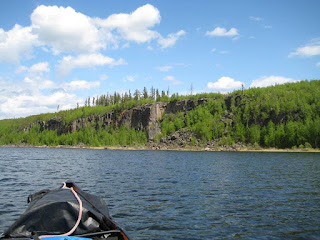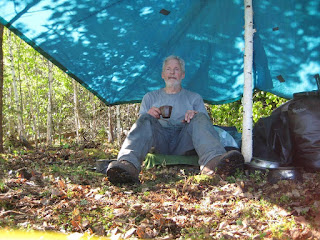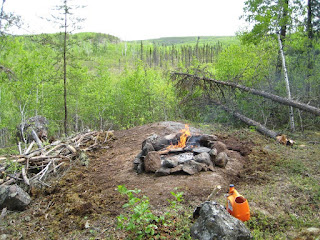I canoed upriver, making two portages 360 and 370 metres long which needed minimal clearing, and wading 100 metres above each rapid to reach slow enough water to paddle. Note the common merganser ducks on the boulders in the rapids, two drakes and several hens.
Camp 8, after travelling 15 km, including two portages (730 metres), and wading two rapids (200 metres). The pile of brush and trees laying behind the tarp are those that had to be cut down to clear a spot to erect the tarp.
The spot where the moose were. This is the shore across from my camp where a cow moose and her calf came out to the lake to drink. By the time I reacted to the sound of her in the water it was too late to get a photo.
Some gear is stored under the canoe, and some in the tent vestibules.
Drying the canvas tent after using it four camps ago.
When I scout for a campsite, there are three main considerations - access to water, a level spot for the tent sheltered from wind, and a safe place for a fire ideally sheltered from wind. It can take a while to search a tent site, and, like this location, is often some distance from the fireplace, 100 metres or more away. Such a place can take a while to clear and can include felling some trees, cutting out roots and stumps and levelling a decent spot for my bed. The tent is positioned at the best angle to take advantage of the most level spot.
A stormy day did not deter a beaver from swimming by to check me out.
Strong winds brought waves right up into my first fireplace and made the tarp shelter miserable. I moved 150 metres farther away to a nicely sheltered spot on a rock face overlooking a beautiful green valley. It was necessary to first cut a trail to the new location.
A big scare while staking out my tarp shelter. I did not realize that the large round-shaped boulder was precariously held in place by the small alder tree (now to its left in the photo). Just after tying the blue rope to a shrub below, the boulder rolled down on top of the line directly beside me. I tried moving the boulder but could not budge it. Aie! When I broke camp, I had to cut the line.
An old beaver lodge with a big hole through the top. I see abandoned lodges like this with a big opening and always wonder what made the hole. Was it a bear and if so why? Any animals inside would have escaped by the time the hole was created. Did the beaver make the hole, but if so why? The bottom photo is the inside of the lodge.













































